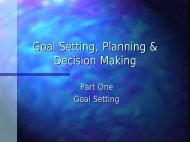Goal Setting, Planning and Decision Making
Goal Setting, Planning and Decision Making
Goal Setting, Planning and Decision Making
Create successful ePaper yourself
Turn your PDF publications into a flip-book with our unique Google optimized e-Paper software.
<strong>Goal</strong> <strong>Setting</strong>, <strong>Planning</strong> <strong>and</strong> <strong>Decision</strong><br />
<strong>Making</strong><br />
911 th Airlift Wing<br />
Family Support Office
Table of Contents<br />
PART ONE - GOAL SETTING Page 1<br />
A. <strong>Goal</strong> <strong>Setting</strong> Page 1<br />
B. Establishing Life time <strong>Goal</strong>s Page 1-3<br />
C. How to Achieve Your Lifetime <strong>Goal</strong>s Page 3<br />
D. Staying the Course Page 3<br />
E. <strong>Setting</strong> <strong>Goal</strong>s Effectively Page 3<br />
F. Set Performance Not Outcome <strong>Goal</strong>s Page 4<br />
G. Set Specific <strong>Goal</strong>s Page 4<br />
H. <strong>Setting</strong> Realistic <strong>Goal</strong>s Page 4<br />
I. <strong>Setting</strong> <strong>Goal</strong>s Too Low Page 5<br />
J. <strong>Setting</strong> <strong>Goal</strong>s at the Right Level Page 5<br />
K. Thinking a <strong>Goal</strong> Through Page 5<br />
L. Achieving <strong>Goal</strong>s Page 6<br />
M. Failure to Achieve a <strong>Goal</strong> Page 6<br />
N. Achieving the <strong>Goal</strong> Page 6-7<br />
O. Summary of <strong>Goal</strong> <strong>Setting</strong> Page 7<br />
PART TWO - PLANNING Page 8<br />
A. Why Should You Plan Page 8<br />
B. The <strong>Planning</strong> Process Page 8-9<br />
C. Pareto Principle Page 9<br />
D. Why People Avoid <strong>Planning</strong> Page 10-11<br />
E. The <strong>Planning</strong> Cycle Page 12<br />
F. How to Spot What Needs to Be Done Page 13<br />
G. New Ideas Page 13<br />
H. SWOT Analysis Page 13<br />
I. Forced Change Page 14<br />
J. Identifying the Aim of Your Plan Page 14<br />
K. Vision <strong>and</strong> Mission Statements Page 15<br />
L. Exploring Options Page 15<br />
Logical Thinking Page 15-16<br />
Brainstorming Page 17-18<br />
M. Selecting the Best Option Page 18-19<br />
N. Detailed <strong>Planning</strong> Page 19<br />
O. Identifying Key Activities Page 19<br />
P. Prioritizing Activities<br />
Critical Path Analysis Page 20-25<br />
Q. Control Mechanisms Page 26<br />
R. Elements of a Good Plan Page 27<br />
2
S. <strong>Making</strong> Effective Plans Page 27<br />
T. Evaluation of the Plan <strong>and</strong> Its Impact Page 27<br />
U. Plan Evaluation Page 28<br />
PMI Page 28-29<br />
Force Field Analysis Page 29-31<br />
V. Assessing Impact Page 32<br />
W. Implementing Change Page 32<br />
X. Plan Execution Tools Page 33<br />
Y. Managing Change Page 33<br />
Z. Resistance to Change Page 33-34<br />
AA. Closing Projects Page 34<br />
BB. Success Page 35<br />
CC. Summary Page 35-36<br />
PART III – DECISION MAKING PAGE 36<br />
A. <strong>Planning</strong> for <strong>Decision</strong> <strong>Making</strong> Page 36-37<br />
B. <strong>Decision</strong> Levels Page 38-39<br />
C. Some Additional <strong>Decision</strong> <strong>Making</strong> Techniques Page 39<br />
T-Chart Page 39<br />
Buriden’s Ass Page 39-40<br />
Measured Criteria Page 41<br />
Business/Marketing Plans Page 42-43<br />
3
INTRODUCTION<br />
Positive goal setting, effective planning <strong>and</strong> decision making promote a life well<br />
lived. When we fail to set goals we have nothing to plan for, <strong>and</strong> our time is<br />
poorly spent. One of the realities of life is we are affected by our decisions, our<br />
families are, <strong>and</strong> so are others we impact on the job <strong>and</strong> in our community.<br />
<strong>Planning</strong> can make a major difference in the quality of our decision making, as<br />
well as the fulfillment of our goals.<br />
Study about <strong>Goal</strong> <strong>Setting</strong>, planning <strong>and</strong> decision making can help you achieve<br />
new life performance. Whether it be to find a job, gain a promotion, volunteer, or<br />
achieve financial independence.<br />
4
GOAL SETTING<br />
A. <strong>Goal</strong> <strong>Setting</strong>: This is a very powerful technique that can garner strong<br />
returns in all areas of your life. At its most basic level, the process of setting<br />
goals <strong>and</strong> targets allows you to choose where you want to go in life. By knowing<br />
precisely what you want to achieve, you know what you have to concentrate on<br />
<strong>and</strong> improve. <strong>Goal</strong> setting provides you with long term vision, <strong>and</strong> short- term<br />
motivation. It focuses the knowledge you acquire <strong>and</strong> helps organize your<br />
resources.<br />
1. By <strong>Setting</strong> <strong>Goal</strong>s you can:<br />
• Achieve more<br />
• Improve Performance<br />
• Increase your motivation to achieve<br />
• Improve your self-confidence<br />
• Plan to eliminate attitudes that hold you back <strong>and</strong> cause<br />
unhappiness.<br />
2. The advantages of effective goal setting for the goal setter:<br />
• Suffer less from stress <strong>and</strong> anxiety<br />
• Concentrate better<br />
• Show more self-confidence<br />
• Perform better<br />
• Are happier <strong>and</strong> more satisfied.<br />
3. <strong>Goal</strong> <strong>Setting</strong> Helps Self-confidence: By setting goals, <strong>and</strong> measuring<br />
their achievement, you are able to see what you have done <strong>and</strong> what you<br />
are capable of. The process of achieving goals gives you the confidence<br />
<strong>and</strong> self-belief that you need when contemplating higher or more difficult<br />
goals.<br />
B. Establishing Lifetime <strong>Goal</strong>s: <strong>Setting</strong> lifetime goals helps place your<br />
decision-making activities in perspective.<br />
1. Categorical <strong>Goal</strong>s: Take a look at the following areas for lifetime goal<br />
setting.<br />
• Artistic<br />
Do you want to achieve any artistic goals If so, what<br />
• Attitude<br />
Is there any part of your mental attitude that is holding you back<br />
Is there any part of the way you behave that upsets you If so, set<br />
goals to cure the problem, even if that goal is only to get help.<br />
5
Attitude is often “everything”, when we are speaking about the<br />
difference between a life well lived <strong>and</strong> one which features<br />
existence.<br />
• Career<br />
What type of career do you want What level do you wish to<br />
achieve Are you aware there are five factors you may wish to<br />
consider in this process (1) What am I interested in doing (2)<br />
Do people already working in that area share my interests (3)<br />
Does my temperament allow me to do this sort of work over an<br />
extended period of time (4) Do I have the “horsepower” or<br />
aptitude to do this work (5) Do I have the means to obtain the<br />
credentials via education <strong>and</strong> training to perform the career<br />
• Education<br />
Is there any knowledge you want to acquire in particular What<br />
information <strong>and</strong> skills will you need to achieve other goals<br />
• Family<br />
Do you want to be a parent If so, how are you going to be a good<br />
parent How do you want to be seen by a partner, or by members<br />
of your extended family<br />
• Financial<br />
How much do you want to earn by each stage of your life How<br />
much do you want to invest At what age do you want financial<br />
independence<br />
• Physical<br />
Are there any athletic goals you want to achieve Do you want<br />
good health deep into old age What steps are you going to take<br />
to achieve this<br />
• Pleasure<br />
How do you want to enjoy yourself You should ensure some of<br />
your life is reserved just for you.<br />
• Public Service<br />
Do you want to make the world a better place by your existence If<br />
so, how<br />
• Social<br />
Do you have any social ambitions<br />
Once you have decided your goals in these areas assign your priority to them,<br />
with the most important earning an A, the least important earning an F. Then<br />
6
eview your goals <strong>and</strong> re-prioritize until you are satisfied that the goals <strong>and</strong><br />
priorities you have set reflect the shape of the life that you want to lead. Also<br />
ensure that the goals you have set are the goals you, not your parents, spouse,<br />
family, or people around you want them to be.<br />
C. How to Start to Achieve your lifetime goals: Once you have set your<br />
lifetime goals now set a 25-year plan of smaller goals that should be achieved if<br />
you are to reach your lifetime plan. Then set a 5 year plan, 1 year plan, 6 month<br />
plan, I month plan of progressively smaller goals that should be reached to<br />
achieve your lifetime goals. Finally set a daily to do list of things you should do<br />
today to reach your lifetime goals. At this stage many of your goals may simply<br />
be to read books <strong>and</strong> gather information on the achievement of your goals so<br />
that you can improve the quality <strong>and</strong> realism of your goal setting.<br />
D. Staying the Course: Once you have decided your goal plans, keep the<br />
process going by reviewing <strong>and</strong> updating your to-do-list on a daily basis. Some<br />
people recommend this as the last thing being done the day before, other as the<br />
first thing done in the morning - this is up to you. Periodically review your other<br />
plans, <strong>and</strong> modify them to reflect your changing priorities.<br />
E. <strong>Setting</strong> <strong>Goal</strong>s Effectively: The following guidelines apply to setting effective<br />
goals.<br />
• Positive Statement: Express your goals positively: “Execute<br />
this detail well” is a much better goal than “don’t make this<br />
stupid mistake.”<br />
• Be Precise: If you set a precise goal, putting in dates, times<br />
<strong>and</strong> amounts so that achievement can be measured, then you<br />
know the exact goal to be achieved, <strong>and</strong> can take complete<br />
satisfaction from having completely achieved it.<br />
• Set priorities: Where you have several goals, give each a<br />
priority. This helps to direct you attention to the most important<br />
ones.<br />
• Write <strong>Goal</strong>s Down: Do this to avoid confusion <strong>and</strong> to give them<br />
more force.<br />
• Keep Operational <strong>Goal</strong>s Small: Keep the goals you are<br />
working towards immediately small <strong>and</strong> achievable. I f a goal is<br />
too large, then it can seem you are not making progress<br />
towards it. Keeping goals small <strong>and</strong> incremental gives more<br />
opportunities for reward. Today’s goals should be derived from<br />
larger goals.<br />
7
F. Set Performance Not Outcome <strong>Goal</strong>s: This is very important. You should<br />
take care to set goals over which you have as much control as possible – there is<br />
nothing as upsetting as failing to achieve a personal goal for reasons beyond<br />
your control such as bad business environments, poor judging, bad weather,<br />
injury or just plain bad luck. <strong>Goal</strong>s based on outcomes are extremely vulnerable<br />
to failure because of things beyond your control.<br />
If you base your goals on personal performance or skills or knowledge to be<br />
acquired, then you can keep control over the achievement of your goals <strong>and</strong><br />
draw satisfaction from them. For example, you might set a personal best time in<br />
a race but be disqualified due to a poor judging decision. A goal to place in the<br />
top three would have then been a disappointment, despite having run your best<br />
time.<br />
Other outcome measures such as financial wealth or external recognition from<br />
colleagues can be fleeting as time goes on. You will either have to perform at a<br />
heroic level for feel less satisfied with the external responses.<br />
G. Set Specific <strong>Goal</strong>s: Set specific measurable goals. If you achieve all<br />
conditions for a measurable goal, then you can be confident <strong>and</strong> comfortable in<br />
its measurement. If you consistently fail to meet a measurable goal, then you<br />
can adjust it or analyze the reason for failure <strong>and</strong> take appropriate action to<br />
improve your skills.<br />
H. <strong>Setting</strong> Realistic <strong>Goal</strong>s: There are numerous reasons why goals can be set<br />
unrealistically high. Some of the more common reasons are listed below.<br />
• Other People: Other people (Parents, media, society) can<br />
set unrealistic goals for you. Based on what they want.<br />
Often this is done in ignorance of goals, desires, <strong>and</strong><br />
ambitions.<br />
• Insufficient Information: If you do not have a clear,<br />
realistic underst<strong>and</strong>ing of what you are trying to achieve<br />
<strong>and</strong> of the knowledge <strong>and</strong> skills to be mastered, it is<br />
difficult to set effective <strong>and</strong> realistic goals.<br />
• Always expecting your best performance: Many people<br />
base their goal on their best performance, however long<br />
ago that was. This ignores the factors that led to the<br />
achievement in the first place. It is better to base your<br />
goals on your average performance, as it is more<br />
realistic.<br />
• Lack of respect for self: If you do not respect your right to<br />
rest, relaxation, <strong>and</strong> pleasure then you risk burnout.<br />
8
I. <strong>Setting</strong> goals too low: Alternatively goals may be set too low because of the<br />
following factors.<br />
• Fear of failure: If you are frightened of failure you will not<br />
take the risks needed for optimum performance. As you<br />
apply goal setting <strong>and</strong> the achievement of goals, your<br />
self-confidence should increase, helping you to take<br />
bigger risks. Know that failure is a positive thing as it<br />
shows you areas where you can improve your skills <strong>and</strong><br />
knowledge.<br />
• Taking it too easy: It is easy to take reasons for not<br />
setting goals unrealistically as an excuse to set them too<br />
low. If you are not prepared to stretch yourself <strong>and</strong> work<br />
hard, then you are extremely unlikely to achieve anything<br />
of real worth.<br />
J. <strong>Setting</strong> goals at the right level: <strong>Setting</strong> goals at the right level is a skill that<br />
is acquired by practice.<br />
• You should set goals so they are slightly out of your<br />
immediate grasp, but not so far that that there is no hope<br />
of achieving them. No one will put a serious effort into a<br />
goal that they believe is unrealistic. However, remember<br />
that a belief that a goal is unrealistic may be incorrect.<br />
Such a belief can be changed by effective use of<br />
imagery.<br />
• Personal factors such as tiredness, other commitments<br />
<strong>and</strong> the need for rest, etc. should be taken into account<br />
when goals are set.<br />
K. Thinking a goal through: When thinking about how to achieve goals, the<br />
following questions can help you focus on the sub-goals that lead to their<br />
achievement.<br />
• What skills do I need to achieve this<br />
• What information <strong>and</strong> knowledge do I need<br />
• What help, assistance, or collaboration do I need<br />
• What resources do I need<br />
• What can block progress<br />
• Am I making any assumptions<br />
• Is there a better way to do things<br />
9
L. Achieving goals: Once you have achieved a given goal take the time to<br />
“smell the roses”. Absorb the significance of the goal achievement, while<br />
observing the progress you are making toward other goals. If the goal was a<br />
significant one, or one that you had worked towards for some time, take the time<br />
to reward yourself.<br />
M. Failure to achieve a goal: Feedback is a wonderful process as it aids<br />
learning. Lessons learned from failure are invaluable. When analyzing a failure<br />
take a look at the following factors that may have played a role.<br />
• That you did not try hard enough.<br />
• That your technique, skills of knowledge were<br />
faulty <strong>and</strong> need to be enhanced.<br />
• That the goal you set was unrealistic.<br />
Use the above information as a means to adjust the goal if it was set too high, or<br />
set goals to acquire new skills or knowledge. Feedback like this turns everything<br />
into a positive learning experience – even failing to meet a goal is a step forward<br />
towards a more perfect performance.<br />
Remember that the act of trying something, even if it does not work, often opens<br />
that would have otherwise remained closed. We only have to remember that<br />
Christopher Columbus failed to find a westward passage to the Indies, to<br />
appreciate the fact that an apparent failure in one area can result in opening up a<br />
whole New World of possibilities.<br />
N. Achieving the goal: Feedback is equally important when analyzing an<br />
achieved goal.<br />
• If the goal was easily achieved, then make your<br />
next goals harder.<br />
• If the goal took a dispiriting length of time to<br />
achieve, make the next goals a little easier.<br />
• If you learned something that would lead you to<br />
alter existing goals then do so.<br />
• If you determined you were deficient in some of<br />
your skills while trying to achieve your goals, then<br />
set goals to achieve skill improvement.<br />
10
<strong>Goal</strong>s often change as we mature, adjust them regularly to reflect this growth in<br />
personality. If goals do not hold any attraction, then let them go – goal setting is<br />
your servant – not your master – it should bring you real pleasure, satisfaction<br />
<strong>and</strong> a sense of accomplishment.<br />
O. Summary of goal setting: The following is a synopsis of this topical area.<br />
• <strong>Goal</strong> setting is an important method of:<br />
<br />
<br />
<br />
<br />
Deciding what is important for you to achieve in<br />
your life<br />
Separating what is important for you from what is<br />
irrelevant<br />
Motivating yourself to achievement<br />
Building your self-confidence based on measured<br />
achievable goals<br />
• You can set goals effectively by:<br />
<br />
<br />
<br />
<br />
<br />
<br />
Phrasing them positively<br />
Defining them precisely<br />
Prioritizing multiple goals<br />
Writing them down<br />
Keeping them manageable; not too hard, not too<br />
easy<br />
<strong>Setting</strong> performance goals, not outcome goals<br />
• Failure in meeting goals is useful in improving techniques <strong>and</strong><br />
long term success as long as you draw useful lessons from it<br />
<strong>and</strong> feed this back into your goal setting program<br />
• You should allow yourself to enjoy the achievement of goals <strong>and</strong><br />
reward yourself appropriately. Lessons should be drawn where<br />
appropriate, <strong>and</strong> should be fed back into the process.<br />
11
PLANNING<br />
A. Why should you plan<br />
When you are about to attempt a project, whether organizing an expedition,<br />
launching a new product or embarking on job search, you inevitably face risks.<br />
These might be:<br />
B. The planning process.<br />
• Risks to life or health<br />
• Risks to status, career or employment<br />
• Problems of lack of resources<br />
• Risks of wasting limited resources whether time<br />
money or power.<br />
• The risk to your self esteem if you fail<br />
• Etc.<br />
<strong>Planning</strong> is the process by which you determine whether you should attempt the<br />
task, work out the most effective way of reaching your target, <strong>and</strong> prepare to<br />
overcome unexpected difficulties with adequate resources. It is the start of the<br />
process by which you turn empty dreams into achievements. It helps you avoid<br />
the trap of working extremely hard but achieving little.<br />
• <strong>Planning</strong> is an up-front investment in success – <strong>and</strong> by applying the<br />
planning process effectively you can:<br />
<br />
<br />
Avoid wasting effort:<br />
It is easy to spend large amounts of time on activities that in retrospect<br />
prove to be irrelevant to the success of the project. Alternatively, you can<br />
miss deadlines by not assessing the order in which dependent jobs should<br />
be carried out. <strong>Planning</strong> helps you achieve the maximum effect from a<br />
given effort.<br />
Take into account all factors, <strong>and</strong> focus on the critical ones:<br />
This insures that you are aware of the implications of what you want to do,<br />
<strong>and</strong> that you are prepared for all reasonable eventualities.<br />
12
Be aware of all changes that will have to be made:<br />
If you know these, then you can assess in advance the likelihood of<br />
being able to make those changes, <strong>and</strong> take action to ensure they will<br />
be successful.<br />
Gather the resources needed:<br />
This will ensure that the project will not fail or suffer for a lack of a<br />
critical resource.<br />
Carry out the task in the most efficient way possible:<br />
So that you can conserve your own resources, avoid wasting<br />
ecological resources, make a fair profit <strong>and</strong> are seen as an effective,<br />
useful person.<br />
• The formal procedure for applying the planning process helps you to:<br />
<br />
<br />
<br />
<br />
<br />
<br />
Take stock of your current position.<br />
Identify precisely what is to be achieved<br />
Detail precisely <strong>and</strong> cost the who, what, when, where, why <strong>and</strong> how of<br />
achieving your target.<br />
Assess the impact of your plan on your organization <strong>and</strong> the people<br />
within it, <strong>and</strong> on the outside world.<br />
Evaluate whether the effort, costs <strong>and</strong> implications of achieving your<br />
plan are worth the achievement. Known negative externalities of the<br />
plan may result in a decision to abort or modify it to avoid known<br />
difficulties.<br />
Consider the control mechanisms, whether reporting quality or cost<br />
controls, etc. that are needed to achieve your plan <strong>and</strong> keep it on track.<br />
C. Pareto Principle<br />
You may have heard of one approach to the Pareto Principle: that 80% of a job is<br />
completed in 20% of the time. Another application of the principal in a nonplanning<br />
environment is that 80% of the effort tends to achieve 20% of the<br />
results. By thinking <strong>and</strong> planning, we can reverse this to 20% of the effort<br />
achieving 80% of the results. We may even decide that it is more efficient not to<br />
attempt the remaining work at all!<br />
13
D. Why do people avoid planning There are a number of reasons why<br />
people avoid planning.<br />
• Organizational problems:<br />
<br />
<br />
<br />
<br />
Poor reward structures<br />
Where an organization assumes success, it will often fail to reward it.<br />
Where failure occurs, then it may be punished in lack of promotion or<br />
redundancy. This often results in a situation where it is better for the<br />
individual to do nothing (<strong>and</strong> not draw attention) than risk trying<br />
something, fail <strong>and</strong> be punished.<br />
Fire-fighting<br />
An organization can be so deeply embroiled in crisis management <strong>and</strong><br />
fire-fighting that it simply does not have time to plan.<br />
The ‘get stuck in’ culture<br />
An organization may oppose planning as a waste of time. This may be<br />
because the organization is doing a very simple job, or where<br />
managers are so experienced in a job that they do not appreciate that<br />
they are planning. The approach cripples inexperienced staff by<br />
denying them the benefits of planning, <strong>and</strong> puts more loads on<br />
experienced managers.<br />
Opposition to time <strong>and</strong> expense of planning<br />
Time spent on planning is an investment. Some organizations are<br />
culturally opposed to spending resources. Sometimes this may be<br />
appropriate, but often it is shortsighted.<br />
• Individual Avoidance of <strong>Planning</strong><br />
Where people are resistant to planning, this can result from:<br />
<br />
<br />
<br />
Laziness<br />
People may simply not be bothered to devote the time to thinking a<br />
plan through.<br />
Lack of Commitment <strong>and</strong> Resistance to Change<br />
The individuals may not see the benefits of the planning process, may<br />
believe there is no need to plan, or may perceive things are okay as<br />
they st<strong>and</strong>.<br />
Fear of Failure<br />
By not taking action there is little risk of failure unless a problem is<br />
urgent <strong>and</strong> pressing. Whenever something worthwhile is attempted<br />
there is risk of failure.<br />
14
Experience<br />
As individuals amass experience they may find that they rely less<br />
<strong>and</strong> less on formalized planning. This may be appropriate. It is<br />
easy, however, to be overconfident <strong>and</strong> overestimate experience –<br />
forethought is rarely wasted <strong>and</strong> is the mark of professionalism<br />
Poor experience of planning<br />
People may have had a previous bad experience with planning,<br />
where plans have been long, cumbersome, impractical or inflexible.<br />
<strong>Planning</strong>, like anything, can be done badly. Done properly,<br />
planning can be highly beneficial.<br />
15
E. The planning cycle<br />
<strong>Planning</strong> is best thought of as a cycle, not a straight-through process: once a<br />
plan has been devised it should be evaluated. This evaluation may be cost or<br />
number based, or may use other analytical tools. This analysis may show that<br />
the plan specified may cause unwanted consequences, may cost too much, or<br />
may simply not work.<br />
In this case the planning process will have to cycle back to an earlier stage, or<br />
the plan may have to be ab<strong>and</strong>oned altogether – the outcome of your planning<br />
may simply be that it is best to do nothing!<br />
The stages of the planning cycle that will be explained below:<br />
The <strong>Planning</strong> Cycle<br />
Analysis of Current<br />
Position<br />
Identify Aim<br />
Explore Options<br />
D<br />
Detailed <strong>Planning</strong><br />
Plan Evaluation<br />
Plan Implementation<br />
Closure of Plan<br />
Feedback<br />
Once we have examined the planning cycle we will look at managing change <strong>and</strong><br />
completing projects.<br />
16
F. How to spot what needs to be done<br />
<strong>Planning</strong> may be done on a routine basis or may need to be carried out as a<br />
result of new ideas, poor performance or pressure from customers or the<br />
organization’s environment. This section examines how you can clarify the<br />
problems <strong>and</strong> opportunities that face you.<br />
G. New Ideas<br />
One simple approach to generating ideas is to look at what irritates you in your<br />
life <strong>and</strong> what seems unnecessarily laborious <strong>and</strong> tedious. Often this will prompt<br />
ideas for improvements, whether these are administrative changes in your<br />
organization or are ideas for new consumer products or services.<br />
H. SWOT Analysis – Strengths, Weaknesses, Opportunities, Threats<br />
A more systematic method is to use SWOT Analysis to detail or examine your<br />
organization’s Strengths <strong>and</strong> Weaknesses, <strong>and</strong> to examine the Opportunities <strong>and</strong><br />
Threats it faces. Often carrying out an analysis using the SWOT framework will<br />
be enough to reveal the changes that can be usefully made.<br />
To carry out a SWOT Analysis for yourself or your organization, write down<br />
answers to the following questions:<br />
Strengths Weaknesses Opportunities Threats<br />
What are your<br />
advantages<br />
What could be<br />
improved<br />
What are the good<br />
chances facing<br />
What obstacles do you<br />
face<br />
you<br />
What do you do What is done What are the What is your competition<br />
well<br />
Be realistic, look at<br />
it from your point<br />
of view <strong>and</strong> from<br />
your customers<br />
point of view.<br />
If stumped start by<br />
writing down a list<br />
of your<br />
organizations<br />
characteristics.<br />
badly<br />
What should<br />
be avoided<br />
Face any<br />
unpleasant<br />
truths now,<br />
rather than at<br />
a crucial point.<br />
interesting trends<br />
Useful opportunities<br />
come from changes<br />
in technology <strong>and</strong><br />
markets on both a<br />
broad <strong>and</strong> industry<br />
specific scale.<br />
From changes in<br />
governmental<br />
policy, or changes<br />
in social patterns,<br />
population profiles<br />
lifestyle changes, or<br />
employment trends.<br />
doing<br />
Are the required<br />
specifications for your<br />
products <strong>and</strong> services<br />
changing<br />
Do you have bad debt or<br />
cash flow problems<br />
17
I. Forced change<br />
In some cases you may need to approach planning as a result of pressure for<br />
change. This can come about as a result of:<br />
♦ Internal Factors<br />
• New products, services or requirements of your organization<br />
• New technology, i.e. computers, inter/intranets, cell phones, equipment<br />
• Changes in the structure of your organization<br />
♦ External Factors<br />
• Changes in the economy<br />
• Legal changes<br />
• Appearance of new technology or ideas<br />
• Competition<br />
• Social changes<br />
• Politics<br />
In cases where change is forced on you, ensure you respond to the cause of the<br />
pressure, not to the symptoms of it.<br />
J. Identifying the aim of your plan<br />
Once you have completed a realistic analysis of your current position, the next<br />
stage of the <strong>Planning</strong> Cycle is to decide what the aim of your plan is Deciding<br />
<strong>and</strong> defining an aim sharpens the focus of your plan, <strong>and</strong> helps you avoid<br />
wasting your time on irrelevant side issues.<br />
The aim is best expressed in a simple single sentence. This ensures that it is<br />
clear <strong>and</strong> sharp in your mind.<br />
18
If you are having difficulty in deciding the aim of your plan, ask yourself:<br />
• What do I want the future to be<br />
• What benefits do I want to give my customers<br />
• What returns do I seek<br />
• What values do my organization <strong>and</strong> I believe in<br />
By answering all of the above questions you <strong>and</strong> anyone else you are working<br />
with have the basis for exchanging opinions in an ethical format. Sharing<br />
opinions about aims will help with the buy-in later on.<br />
K. Vision & Mission Statements<br />
The aim of the plan can often be broken down into a Vision Statement <strong>and</strong> a<br />
Mission Statement.<br />
The Vision Statement typically is the aim of the highest level plan for the<br />
organization, <strong>and</strong> expresses the benefit that the organization provides to its<br />
customers, or the organizations ultimate aim.<br />
The Mission Statement gives concrete expression to the Vision Statement,<br />
explaining how it will be achieved.<br />
L. Exploring Options<br />
When you know where you are, <strong>and</strong> know where you want to go, the next stage<br />
is to work out how you could get there. Although it is always important to take<br />
other people’s views into account, ensure that you think for yourself during this<br />
process.<br />
The first stage of this is to explore options available to you. There are several<br />
techniques available for doing this:<br />
• Logical Thinking<br />
An effective way to do this is to diagram your thinking. Start by writing your<br />
aim in the in the center of a large piece of paper. Radiating from this, draw a<br />
line for each of the solutions you can think of, <strong>and</strong> note the solution with each<br />
line. After doing that, using additional lines, express all of the ways a solution<br />
can be accomplished. Do this until you have completed all possible solutions.<br />
See sample below:<br />
19
SAMPLE<br />
Write combination resume<br />
Have someone write<br />
resume for you NOT!<br />
Write chronological<br />
resume<br />
Write Resume<br />
Obtain a new job<br />
Target types of jobs<br />
Practice<br />
Interviewing<br />
Check the Internet<br />
Perform Job Search<br />
Call Friends & friends of<br />
friends<br />
Go to unemployment office<br />
Fill out applications using a<br />
master application.<br />
Read<br />
paper<br />
Go to temporary<br />
agencies<br />
The above sample is not exhaustive but it provides an idea of the concept<br />
20
• Brainstorming<br />
This is a technique, generally done in a group, but can be done singularly, for<br />
developing creative <strong>and</strong> unusual solutions to problems. The process is free<br />
wheeling <strong>and</strong> uncritical. The concept is to generate ideas <strong>and</strong> approaches<br />
that are deliberately strange. These will inspire unusual solutions that can be<br />
developed by either logical thought or further brainstorming.<br />
1. What is brainstorming<br />
Brainstorming is a method for developing creative solutions to<br />
problems. It works by focusing on a problem, <strong>and</strong> then deliberately<br />
coming up with as many deliberately unusual solutions as possible <strong>and</strong><br />
by pushing ideas as far as possible.<br />
One approach to brainstorming is to “seed” the session with a word<br />
pulled r<strong>and</strong>omly from a dictionary. This word can be used as a<br />
starting point in the process of generating ideas.<br />
During the brainstorming session there is no criticism of ideas – the idea is to<br />
open up as many possibilities as possible, <strong>and</strong> break down preconceptions<br />
about limits to the problem.<br />
Once this has been done, the results of the brainstorming session can be<br />
analyzed <strong>and</strong> the best solutions can be explored either using further<br />
brainstorming or more conventional solutions.<br />
2. How to brainstorm<br />
The following rules are important to brainstorming successfully<br />
• A leader should take control of the session, initially defining the problem to be<br />
solved with any criteria that must be met, <strong>and</strong> then keeping the session on<br />
course. He or she should encourage an enthusiastic, uncritical attitude among<br />
brainstormers <strong>and</strong> encourage participation by all members on the team. The<br />
session should be announced as lasting a fixed period of time, <strong>and</strong> the leader<br />
should ensure that no train of thought is followed for too long. The leader<br />
should try to steer it towards development of some practical solutions.<br />
• Participants in the brainstorming process should come from as wide a range of<br />
disciplines as possible. This brings many more creative ideas to the session.<br />
• Brainstormers should be encouraged to have fun brainstorming, coming up with<br />
as many ideas as possible, from solidly practical ones to wildly impractical ones in<br />
an environment where creativity is welcomed.<br />
• Ideas should not be criticized or evaluated during the brainstorming session.<br />
Criticism introduces an element of risk for a group member in putting forward<br />
21
an idea. This stifles creativity <strong>and</strong> cripples the free running nature of a good<br />
brain storming session.<br />
• Brainstormers should not only come up with new ideas in a brainstorming<br />
session, but also should ‘spark off’ from associations with other people’s ideas<br />
<strong>and</strong> develop other people’s ideas.<br />
• A record should be kept of the session either as notes or a tape recording. This<br />
should be studied subsequently for evaluation. It can also be helpful to jot down<br />
ideas on a board that can be used by all brainstormers.<br />
3. Individual versus Group Brainstorming<br />
Individuals, groups or both can either carry out brainstorming:<br />
• Individual brainstorming tends to produce a wider range of ideas than group<br />
brainstorming, but tends not to develop the ideas as effectively, perhaps as<br />
individuals on their own run up against problems they cannot solve. Individuals<br />
are free to explore ideas in their own time without any fear of criticism, <strong>and</strong><br />
without being dominated by other group members.<br />
• Group brainstorming develops ideas more deeply <strong>and</strong> effectively, as when<br />
difficulties in the development of an idea by one person are reached, another<br />
person’s creativity <strong>and</strong> experience can be used to break them down. Group<br />
brainstorming tends to produce fewer ideas (as time is spent developing ideas in<br />
depth) <strong>and</strong> can lead to the suppression of creative but quiet people by loud <strong>and</strong><br />
uncreative ones.<br />
• Individual <strong>and</strong> group brainstorming can be mixed, perhaps by defining a<br />
problem, <strong>and</strong> the letting team members initially come up with a wide rang of<br />
possibly shallow solutions. These solutions could then be enhanced <strong>and</strong><br />
developed by group brainstorming.<br />
• Research<br />
Similar problems may well have been faced by people you know, or may be<br />
documented in material that is available to you. Don’t forget to check these<br />
sources.<br />
M. Selecting the best option<br />
Once you have explored the options available to you, it is time to decide which<br />
one to select. If you have the time <strong>and</strong> the resources available, <strong>and</strong> then you<br />
might decide to evaluate all options, carrying out detailed planning, risk<br />
22
assessment for each. In the absence of that the best option is to build a decision<br />
tree.<br />
SAMPLE DECISION TREE<br />
Go to Temp Agency<br />
Good<br />
Job Search<br />
Go to Unemployment<br />
Office<br />
Moderate<br />
Getting a job<br />
Read Newspaper<br />
Poor<br />
Use Internet<br />
Go to Friends to<br />
network<br />
Fill out applications using<br />
master application<br />
Poor<br />
Moderate<br />
Good<br />
N. Detailed planning<br />
By the stage where you begin detailed planning, you should have a pretty good<br />
picture of where you are, what you want to achieve <strong>and</strong> the range of options<br />
available to you as the most likely to yield the results required.<br />
Detailed planning is the process of working out the most efficient <strong>and</strong> effective<br />
way of achieving the aim you have defined. It is the process of determining who<br />
will do what, when, where, how <strong>and</strong> why <strong>and</strong> at what cost.<br />
O. Identifying key activities<br />
The first stage is in the process is to identify the key actions that need to be<br />
performed in order to achieve the aim of the plan. If these actions are large <strong>and</strong><br />
complex, reduce them down to a number of smaller key actions.<br />
For each of these key actions, plan out how they will be achieved, working out<br />
the time that will need to be taken <strong>and</strong> the resources that will need to be<br />
allocated to achieve the action. This will allow you to calculate the costs of that<br />
action.<br />
23
P. Prioritizing activities<br />
Once you have done this, prioritize the actions in order of importance so that you<br />
do not waste time on low priority tasks. It can also be helpful to set mock<br />
deadlines (allowing appropriate contingency time for overruns <strong>and</strong> unavoidable<br />
delays). This gives a target to work towards.<br />
If some of the actions being carried out depend on the completion of other<br />
activities, it may be useful to carry out a Critical Path Analysis. This will show<br />
you the minimum length of time that will be needed to achieve the plan, <strong>and</strong> will<br />
help you to decide task priorities. It will also help you to identify the key activities<br />
to keep moving when your resource requirements conflict with other<br />
managers/colleagues/family members using the same resources.<br />
Critical Path Analysis<br />
Critical path analysis is an extremely effective way of analyzing a complex<br />
project. It helps you calculate the minimum length of time in which a project can<br />
be completed, <strong>and</strong> which activities should be prioritized to complete by that date.<br />
Where a job has to be completed on time, critical path analysis helps you focus<br />
on the essential activities to which attention <strong>and</strong> resources should be devoted. It<br />
gives an effective basis for the scheduling <strong>and</strong> monitoring of progress.<br />
• Sequential <strong>and</strong> parallel activities<br />
The essential concept behind Critical Path Analysis is that some plan activities<br />
are dependent on other activities being completed first.<br />
These dependent activities need to be completed in a sequence, with each<br />
activity being more-or-less completed before the next activity can begin.<br />
Dependent activities are also called “sequential” activities.<br />
Other activities are not dependent on completion of any other tasks, or may be<br />
done at any time before or after a particular stage is reached. These are nondependent<br />
or ‘parallel’ tasks.<br />
• Method<br />
The process of carrying out a critical path analysis is shown below.<br />
1. List all activities in path<br />
Show the earliest start date, estimated duration <strong>and</strong> whether tasks are<br />
parallel or sequential. If the tasks are sequential, show what they depend on.<br />
24
This will show a task list like the one below (simplified custom computer<br />
installation):<br />
NB: Start week shows purely when resources become available: Whether a task is<br />
parallel or sequential depends largely on the context.<br />
ο<br />
ο<br />
ο<br />
ο<br />
1. High level analysis<br />
Start week 1, 5 days, sequential<br />
2. Selection of hardware platform<br />
Start week 1, 1 day, sequential<br />
Dependent on 1<br />
3. Installation <strong>and</strong> commissioning of hardware<br />
Start week 3, 2 weeks, parallel<br />
Dependent on (2) any time after<br />
4. Detailed analysis of core modules<br />
Start week 1, 2 weeks, sequential<br />
Dependent on (1)<br />
ο<br />
ο<br />
ο<br />
ο<br />
ο<br />
ο<br />
5. Detailed analysis of supporting utilities<br />
Start week 1, 2 weeks, sequential<br />
Dependent on (4)<br />
6. Programming of core modules<br />
Start week 4, 3 weeks, sequential<br />
Dependent on (4)<br />
7. Programming of supporting modules<br />
Start week 4, 3 weeks, sequential<br />
Dependent on (5)<br />
8. Quality assurance of core modules<br />
Start week 5, 1 week, sequential<br />
Dependent on (6)<br />
9. Quality assurance of supporting modules<br />
Start week 5, 1 week, sequential<br />
Dependent on (7)<br />
10. Core module training<br />
Start week 7, 1 day, parallel<br />
Dependent on (6) any time after<br />
25
ο<br />
ο<br />
ο<br />
ο<br />
ο<br />
11. Development of accounting reporting<br />
Start week 6, 1 week, parallel<br />
Dependent on (5) any time after<br />
12. Development of management reporting<br />
Start week 6, 1 week, parallel<br />
Dependent on (5) any time after<br />
13. Development of management analysis<br />
Start week 6, 2 weeks<br />
Dependent on (5) any time after<br />
14. Detailed training<br />
Start week 7, 1 week, sequential<br />
Dependent on (1-13)<br />
15. Documentation<br />
Start week 4, 2 weeks, parallel<br />
2. Head up graph paper with the days or weeks to task completion<br />
3. Plot the tasks on the graph paper<br />
Start on the earliest dates, <strong>and</strong> mark the duration. Show the tasks as arrows,<br />
<strong>and</strong> the ends of tasks with dots. Above the task arrows, mark the time taken<br />
to complete the task. Do not worry about task scheduling yet, all we are<br />
doing is setting up the first draft of the analysis.<br />
Once you have plotted the tasks, plot in lines to show dependencies.<br />
This will produce an untidy draft analysis like the one on the next page.<br />
26
Critical Path Analysis- Example 1 – First Draft<br />
Week<br />
1 2 3 4 5 6 7 8 9 10<br />
1. High level analysis<br />
2. Selection of hardware platform<br />
3. Installation <strong>and</strong> commissioning of hardware<br />
4. Analysis of core modules<br />
5. Analysis of supporting modules<br />
6. Programming of core modules<br />
7. Programming of supporting modules<br />
8. Quality assurance core module<br />
9. QA supporting modules<br />
10. Core module training<br />
11. Develop accounting reporting<br />
12. Develop Management Reporting<br />
13. Develop MIS<br />
14. Detailed training<br />
15. Documentation<br />
4. Scheduling Activities<br />
Take the draft analysis, <strong>and</strong> use it to schedule the actions in the plan, in such<br />
a way that sequential actions are carried out in the required sequence.<br />
Parallel actions should be scheduled so that they do not interfere with<br />
sequential actions on the critical path, if possible.<br />
While scheduling, bear in mind the resources you have available, <strong>and</strong> allow<br />
some slack time in the schedule for hold-ups, over-runs, failures in delivery,<br />
etc.<br />
• Presenting the analysis<br />
The final stage in this process is to prepare a clean copy of the analysis. This<br />
should combine the draft analysis (see above) with your scheduling <strong>and</strong><br />
analysis of resources to show when you anticipate that jobs should start <strong>and</strong><br />
finish.<br />
There are two formats for this clean copy. The choice of the most effective<br />
form of presentation comes down to the circumstances of the analysis <strong>and</strong><br />
personal taste.<br />
27
1. GANTT Charts<br />
A redrawn <strong>and</strong> scheduled version of the analysis above is shown below, in<br />
the format of a modified Gantt Chart<br />
Critical Path Analysis- Example 2 – Schedules Activities<br />
Week<br />
1 2 3 4 5 6 7 8 9 10<br />
• 1. High level analysis<br />
(1)<br />
• 4. Analysis of core modules<br />
(2)<br />
• 6. Programming of core modules<br />
(3)<br />
• 8.Quality assurance, core modules<br />
(1)<br />
• 10. Core modules training (1 day)<br />
• 5. Analysis of supporting modules<br />
(2)<br />
• 7. Programming supporting modules<br />
(3)<br />
• 9. QA supporting modules<br />
(1) (1)<br />
• 14. Detailed training<br />
• 11. Develop accounting reporting<br />
(1)<br />
• 2. Selection of hardware platform<br />
(1 day)<br />
• 3. Installation <strong>and</strong> commissioning of hardware<br />
(2)<br />
• 15. Documentation<br />
(2)<br />
(1)<br />
• 12. Develop management reporting<br />
(1)<br />
• 13.Develop MIS<br />
• Critical Path Action<br />
(2) (2)<br />
• Non –Critical path Action<br />
Here time is marked out in columns across the chart, with individualized tasks<br />
represented as arrows terminating at dots. The length <strong>and</strong> positions of the<br />
arrows show the start date <strong>and</strong> duration of tasks.<br />
28
You may prefer to show tasks in pure GANTT format, as solid bars rather than<br />
arrows terminating in dots. Similarly you may prefer not to show the linkages<br />
between related tasks, this a matter of personal taste <strong>and</strong> convention.<br />
The Critical Path is the sequence of dependent activities that lead to the<br />
completion of the plan. Any delay of a stage in the critical path will delay<br />
completion of the whole plan unless future sequential activities are speeded up.<br />
2. PERT Charts<br />
PERT st<strong>and</strong>s for Program Evaluation <strong>and</strong> Review Technique. Here<br />
circles represent completion of tasks, with linking lines showing the<br />
time taken to achieve the tasks. The critical path for the project is<br />
shown as the horizontal series of tasks.<br />
Note that in the diagram below, we are using dotted lines to link<br />
completed tasks back to the appropriate stages at the critical path.<br />
These lines serve to tidy the diagram <strong>and</strong> do not represent tasks to be<br />
carried out. This diagram shows our example critical path analysis in<br />
PERT format:<br />
Critical Path Analysis- Example 2 – Analysis in PERT Format<br />
Week<br />
1 2 3 4 5 6 7 8 9 10<br />
8 10<br />
• • •<br />
(1) (1 day)<br />
6<br />
4 ( 3)<br />
(2) 7 9 14<br />
• • • • • •<br />
(1) (2) (3) (1) (1)<br />
1 5 11<br />
(1)<br />
2 (1 day) 12 13<br />
• • •<br />
(1) (1)<br />
3 15<br />
• • •<br />
(2) (2)<br />
•Critical Path Action<br />
•Non-critical Path Action<br />
(2) (2) No. of weeks to achieve task<br />
1. High level analysis 8. Quality assurance, core modules<br />
2. Selection of software platform 9. QA, supporting modules<br />
3. Installation of hardware 10. Core module training<br />
4. Analysis of core modules 11. Develop accounting reporting<br />
29
5. Analysis of supporting modules 12. Develop management reporting<br />
6. Programming of core module 13. Develop MIS<br />
7. Programming of support modules 14. Detailed training<br />
15. Documentation<br />
Carrying out the example critical path analysis above shows us :<br />
• That if all goes well the project can be completed in 10 weeks.<br />
• That if we want to complete the task as rapidly as possible, we need:<br />
ο 1 analyst for the first 5 weeks<br />
ο 1 programmer for 6 weeks starting at week 4<br />
ο 1 programmer for 3 weeks starting at week 6<br />
ο Quality assurance for weeks 7 <strong>and</strong> 9<br />
ο Hardware to be installed by week 7<br />
• That the critical path is the path for development <strong>and</strong> installation of<br />
supporting modules<br />
• That hardware installation is a low priority task as long as it is<br />
completed by the end of week 7<br />
Summary<br />
Critical Path Analysis is <strong>and</strong> effective <strong>and</strong> powerful method of assessing :<br />
• Tasks which must be carried out<br />
• Where parallel activity can be carried out<br />
• The shortest time a project can be completed<br />
• Resources needed to achieve a project<br />
• The sequence of activities, scheduling, <strong>and</strong> timings involved<br />
• Task priorities<br />
• Etc.<br />
An effective critical path analysis can make the difference between success<br />
<strong>and</strong> failure on complex projects, <strong>and</strong> can be an effective tool for assessing the<br />
importance of problems faced during the implementation process.<br />
Q. Control Mechanisms<br />
While you are concentrating on the actions that need to be performed, ensure<br />
that you are also considering the control mechanisms that will allow you to<br />
monitor the performance of the activity. These will include the activities such<br />
as reporting. Quality assurance, cost control, etc. that are needed to spot <strong>and</strong><br />
correct any deviations form the path.<br />
30
R. Elements of a Good Plan<br />
A good plan will:<br />
♦ Have a clear statement of the current situation<br />
♦ Have a clear aim<br />
♦ Reflect the resources available<br />
♦ Detail the tasks to be carried out, whose responsibility they are, their<br />
priorities, <strong>and</strong> deadlines.<br />
♦ Explain control mechanisms that will alert the manager to difficulties in<br />
achieving the plan.<br />
♦ Plan for contingencies, so that a rapid effective response may be made to<br />
crises, perhaps at a time when you are at low ebb or confused following a<br />
setback.<br />
S. <strong>Making</strong> Effective Plans<br />
The following points will help to make your plan effective.<br />
♦ Involve people affected by the plan to gain their support<br />
♦ Explain why the plan is being carried out<br />
♦ Ensure that the required resources are available <strong>and</strong> remain available.<br />
♦ As far as possible keep existing ways of doing things. This avoids<br />
unnecessary disruption.<br />
♦ Build in milestones <strong>and</strong> review progress. This helps to keep a sense of<br />
movement in the plan, <strong>and</strong> allows achievement to be rewarded.<br />
♦ Use KISS (Keep it simple <strong>and</strong> straightforward)<br />
♦ Keep the plan flexible<br />
♦ Consider traditional arrangements, how will you keep things going while<br />
you implement the plan<br />
T. Evaluation of the plan <strong>and</strong> its impact<br />
Once you have worked out the details of your plan, the next stage is to work<br />
out whether it will work <strong>and</strong> its impact: often you may find that the plan will<br />
have unexpected effects, either positive or negative.<br />
You may also find that when you cost the plan, <strong>and</strong> compare it against the<br />
benefits achieved, that the plan is simply not worth carrying out. This can be<br />
frustrating after the hard work of detailed planning, however it is much better<br />
to find this out than when you have invested time, resources <strong>and</strong> personal<br />
st<strong>and</strong>ing in the success of the plan. Evaluating the plan now gives you the<br />
31
opportunity to either investigate other options that might be more successful<br />
or to accept that no plan is needed or should be carried out.<br />
U. Plan Evaluation<br />
There are a number of ways in which you can evaluate your plan:<br />
Cost/Benefit Analysis<br />
This is probably one of the simplest ways of evaluating a plan. During the<br />
process above you should have carried out an analysis of the costs<br />
involved with each activity within the plan. Simply add up these costs, <strong>and</strong><br />
compare them with expected benefits.<br />
PMI<br />
Once you have carried out a cost/benefit analysis, you may find it useful to<br />
mix its financial information with an assessment of the intangible or nonfinancial<br />
aspects of the decision. An effective way of doing this is with a<br />
PMI analysis. This is an advanced form of ‘weighing the pros <strong>and</strong> cons’,<br />
<strong>and</strong> involves listing the positive points in the plan in one column, the<br />
negative points in a second column. Each point can be allocated a<br />
subjective positive or negative score.<br />
1. What is PMI<br />
PMI – Plus/Minus/Interesting<br />
PMI st<strong>and</strong>s for ‘Plus/Minus/Interesting’. It is a valuable development (by<br />
Edward de Bono) of the ‘pros <strong>and</strong> cons’ technique used for centuries.<br />
PMI is a basic decision making tool. When you are facing a difficult decision,<br />
simply draw up a table headed up ‘Plus’, ‘Minus’, <strong>and</strong> ‘Interesting’. In the<br />
column underneath the ‘Plus’ heading, write down all the positive points of<br />
taking the action. Underneath the ‘Minus’ heading write down all the negative<br />
effects. In the ‘Interesting’ column write down the extended implications of<br />
taking action, whether positive or negative.<br />
2. Scoring your PMI Table<br />
You may be able to make a decision just from the table you have drawn up. Alternatively,<br />
consider each of the points you have written down <strong>and</strong> assign a positive or negative score to<br />
each appropriately. The scores you assign can be entirely subjective. Once you have done<br />
this, add up the score. A strongly positive score indicated that an action should be taken, a<br />
strongly negative score that it should be avoided.<br />
An example is shown below:<br />
32
Should I move to the big city<br />
Plus Minus Interesting<br />
More going on +5 Have to sell my house –6 Easier to find a new job +1<br />
Easier to see my friends +5 More pollution –3 Meet more people +2<br />
Easier to get places + 3 Less space –3 More difficult to get work done -3<br />
No countryside –2 More difficult to get to work -5<br />
13 -14 -5<br />
Total = -6 – I’m happier living just outside of the city<br />
Force field analysis<br />
Similar to PMI, Force Field Analysis helps you get a good overall view of all<br />
the forces for <strong>and</strong> against the change you want to implement. This allows you<br />
to see where you can make adjustments that will make the plan more likely to<br />
succeed.<br />
Force Field Analysis<br />
1. Force Field Analysis<br />
Force Field Analysis is a method used to get a whole view of all the forces for<br />
or against a plan so that a decision can be made which takes into account all<br />
interests. In effect this is a specialized method of weighing pros & cons.<br />
Where a plan has been decided on, force field analysis allows you to look at<br />
all the forces for or against the plan. It helps you to plan or reduce impact of<br />
the opposing forces, <strong>and</strong> strengthen <strong>and</strong> reinforce the supporting forces.<br />
2. Carrying out a Force Field Analysis<br />
To carry out a force field analysis, follow the following steps:<br />
♦ List all forces for change in one column, <strong>and</strong> all forces against change in<br />
another.<br />
♦ Assign a score to each force, from 1 (weak) to 5 (strong).<br />
♦ Draw a diagram showing the forces for <strong>and</strong> against, <strong>and</strong> the size of the<br />
forces.<br />
3. Example Force Field Analysis<br />
An example of the analysis is shown below:<br />
33
Force Field Analysis Example<br />
Force For Change<br />
Forces Against Change<br />
Customers want<br />
New products 4 PLAN:<br />
Loss of staff<br />
3 Overtime<br />
Staff frightened of<br />
3 new technology<br />
Upgrade<br />
Improve speed<br />
factory with<br />
Of production 2 new Environmental impact<br />
Manufacturing 1 of new techniques<br />
machinery<br />
Raise volumes of 3<br />
Output<br />
3 Cost<br />
Maintenance costs<br />
Increasing 1<br />
1<br />
Disruption<br />
TOTAL: 10 TOTAL: 11<br />
Once you have carried out an analysis, you can decide on the viability of the<br />
project.<br />
Where you have decided to carry out a project, it can help you analyze how you<br />
can push through a project that may be in difficulty. Here you have two choices:<br />
• To reduce the strength of the forces opposing a project<br />
• To increase the forces pushing a project<br />
Often the most elegant solution is the first: just trying to force a change may<br />
cause its own problems as e.g. staff can be annoyed into active opposition to a<br />
plan instead of merely just not welcoming it.<br />
If you were faced with the task of pushing through the project in the example<br />
above, the analysis might suggest a number of points:<br />
34
• By training staff (increase cost by 1) fear of technology could be<br />
eliminated (reduce fear by 2)<br />
• It would be useful to show the staff that change is necessary for<br />
business survival (new force in favor, +2)<br />
• Wages could be raised to reflect new productivity (cost +1, loss<br />
of overtime –2)<br />
• Slightly different machines with filters could be installed (<br />
environmental impact –1)<br />
These changes swing the balance from 11:10 (against the plan), to 8:13 (in<br />
favor of the plan).<br />
4. Summary<br />
Force Field Analysis is an effective method of getting a picture of all of the<br />
forces for <strong>and</strong> against a plan. It helps you to weight the importance of these<br />
factors <strong>and</strong> determines whether a plan is worth pursuing.<br />
Where you have decided to proceed with a plan, carrying out a Force Field<br />
Analysis helps you identify changes that might be made to improve the plan.<br />
Cash Flow Forecasts <strong>and</strong> Break Even Analysis<br />
Where a decision is/has mainly financial implications, such as in business <strong>and</strong><br />
marketing planning, preparation of a Cash Flow Forecast can be extremely<br />
useful. Not only does it allow you to assess the affect of time on costs <strong>and</strong><br />
revenue; it helps in assessing the size of the greatest negative <strong>and</strong> positive<br />
cash flows associated with a plan, <strong>and</strong> provides the basis for accurate breakeven<br />
analysis.<br />
When it is set up in a spreadsheet package, a good Cash Flow Forecast also<br />
functions as an extremely effective model of the plan, allowing the effect of<br />
variation in assumptions to be examined.<br />
Risk Analysis & Contingency <strong>Planning</strong><br />
All of the above analyses broadly assume that the plan functions correctly.<br />
None of them assesses the risks associated with carrying the plan out <strong>and</strong><br />
the potential costs should those risks damage the plan. These risks can be<br />
assessed effectively by using a variant of the <strong>Decision</strong> Tree (illustrated<br />
earlier) which allows you to show the major uncertainties associated with<br />
different stages of the plan, analyzed by probability <strong>and</strong> outcome. Wherever<br />
an outcome is unfavorable, this will help you to assess <strong>and</strong> plan contingency<br />
actions needed <strong>and</strong> the cost of getting the plan on course.<br />
35
V. Assessing Impact<br />
It is important to ensure that you do not rely exclusively on the results of numeric<br />
analysis as the basis of your plan evaluation. Many factors, which are important<br />
to the evaluation of your plan, cannot be quantified.<br />
These factors include:<br />
• Ethical Considerations<br />
This should include an assessment of likely changes in public ethics<br />
over the lifetime of the plan.<br />
• Shareholders<br />
How will the shareholders, owners, or trustees of the organization view<br />
the plan (In the military: the chain of comm<strong>and</strong>, Congress, etc.)<br />
• Members/Employees<br />
What effects will the plan have on the organization’s members or<br />
employees Should these effects st<strong>and</strong> in the way of improving<br />
efficiency<br />
• Customers<br />
Will the plan change the way in which your organization’s customers<br />
view it Will this affect the likelihood of reordering/using the services<br />
• Suppliers<br />
How will your plan affect relations with suppliers<br />
• Public Relations<br />
Will the plan have a positive or negative effect on your organization’s<br />
relations with the public, press, <strong>and</strong> politicians<br />
• Environment<br />
Will it enhance or damage the environment<br />
Any analysis of your plan must be tempered by common sense. It is much<br />
better to change a beautifully crafted plan that analysis shows will not work,<br />
than deal with the consequences after a failed attempt at implementation.<br />
W. Implementing change<br />
Once you have completed your plan <strong>and</strong> decided that it will work satisfactorily, it<br />
is time to implement it. This involves directing resources to complete the<br />
activities specified, <strong>and</strong> monitoring the execution of the activities so that<br />
corrections can be applied if necessary. Monitoring execution also allows you to<br />
determine when the task has been achieved <strong>and</strong> activity can cease.<br />
36
X. Plan Execution Tools<br />
Tools that can help you in the routine execution of the plan are:<br />
• Year Planners<br />
This allows you to show tasks, task duration <strong>and</strong> completed<br />
dates <strong>and</strong> track periods when resources will not be available.<br />
• Diary<br />
For the recording of the achievement dates, intermediate target<br />
dates, <strong>and</strong> routine activities.<br />
• Statistics <strong>and</strong> Analytical tools<br />
These are useful tools for tracking progress.<br />
• Specialized Software<br />
Some companies sell goal setting <strong>and</strong> planning software.<br />
Y. Managing Change<br />
It can be helpful to take four steps to ensure that you manage change effectively:<br />
1. Ensure that everyone underst<strong>and</strong>s why change is necessary. If people are<br />
dissatisfied with the way things are, they will be more likely to welcome<br />
change.<br />
2. Show people how things will be better in the future.<br />
3. Ensure that people underst<strong>and</strong> the plan.<br />
4. Try to ensure that there can be no way of going back to previous ways of<br />
doing things: ensure that only new forms are available, that computer<br />
systems reflect the new way of doing things, <strong>and</strong> that procedures work<br />
smoother under the new system than the old.<br />
Z. Resistance to Change<br />
People can resist your efforts for a number of reasons:<br />
• Self Interest<br />
Where someone has achieved status, privilege or self-esteem through<br />
effective use of an old system, they will often see your plan as a threat.<br />
37
Where the plan threatens paid overtime, people will naturally fear the<br />
impact on their bank balance.<br />
• Fear of the Unknown<br />
People may be uncertain of their abilities to learn new skills, their<br />
aptitude with new systems, or their ability to take on new roles.<br />
• Conscientious Objection or Differing Perceptions<br />
People may sincerely believe that you are wrong. They may view the<br />
situation from a different viewpoint, or may have aspirations for<br />
themselves or the organization that are fundamentally opposed to<br />
yours. It is worth trying to underst<strong>and</strong> their position, however once you<br />
have done so <strong>and</strong> formed an opinion, do what you think is right.<br />
Remember that that different people in different jobs will have different<br />
perceptions of a situation: a sales manager will almost inevitably have<br />
a different view of the right level of commission payments to salesmen<br />
than from the viewpoint of a finance director.<br />
• Suspicion<br />
People may not trust you.<br />
• Conservatism<br />
Organizations or people may simply be opposed to change. This can<br />
result from a feeling that everything is okay, from loss of touch with<br />
customers, from lack of exposure to better ways of doing things, or<br />
from the slowness of the decision making, etc.<br />
If you underst<strong>and</strong> the root of possible resistance to change, you can plan for it<br />
<strong>and</strong> overcome it before it becomes a significant obstacle.<br />
AA.<br />
Closing Projects:<br />
Once a plan has been achieved, the project can be closed.<br />
At this point is often worth carrying out the evaluation of the plan, concentrating<br />
on:<br />
• The quality <strong>and</strong> consistency of delivery achieved<br />
• The work achieved<br />
• The length of time it took to achieve the plan<br />
• The real cost of carrying out the plan against the planned costs<br />
38
BB.<br />
Success<br />
Where the plan has been successfully executed, this is a good time to formally<br />
close the project with a ceremony, whether this is a meal or a party, or a formal<br />
presentation of awards/rewards. Not only does this formally close the plan in<br />
people’s minds; it allows them to feel part of the success. Often the broad<br />
success of a plan can be lost in a volume of tiny adjustments. This can leave<br />
highly effective people unhappy <strong>and</strong> dissatisfied following a success.<br />
CC.<br />
Summary<br />
This section on planning & decision making has shown the following points:<br />
• <strong>Planning</strong> is an important investment in the success of a project.<br />
Carrying out the process is not only prepares you for what lies ahead,<br />
ensuring you have adequate resources <strong>and</strong> use them in the most<br />
effective way possible, but also can warn you that a plan is not worth<br />
pursuing. This is valuable information, however frustrating it may be.<br />
• That people can avoid planning either because organizational<br />
structures are poor or for personal reasons. Where a manager is<br />
highly experienced, he/she may have enough prior knowledge to avoid<br />
the need of a plan on a conscious level. He should not underestimate<br />
the value of his own experience by denying new managers the benefit<br />
of planning.<br />
• Good planning takes place in a cycle, with evaluation following detailed<br />
planning. Where evaluation indicates a plan should not be followed,<br />
you can still return to take a different course with minimal loss. After a<br />
plan you assess the plan, <strong>and</strong> learn how to improve your planning <strong>and</strong><br />
execution. The planning cycle is shown below:<br />
ο<br />
ο<br />
ο<br />
Spotting what needs to be done<br />
By spotting new ideas, SWOT Analysis, or responding to<br />
outside pressure.<br />
Identifying the Aim of your Plan<br />
By asking yourself how you want the future to be. Maybe<br />
prepare a vision or mission statement.<br />
Exploring Options<br />
Firstly evaluating a number of options by Brainstorming<br />
or research. Selecting options with e.g. <strong>Decision</strong> Trees.<br />
39
ο<br />
Plan Evaluation<br />
This allows you to work out the likelihood of your plan<br />
working before you try to implement it. Techniques such<br />
as cost/benefit analysis, PMI, Force Analysis, Cash Flow<br />
Forecasting, Risk Analysis can alert you to unsuspected<br />
considerations. Information learned can be fed back into<br />
the plan.<br />
Plan evaluation should consider intangible points such as<br />
ethics, effects on people, <strong>and</strong> the environment. Where a<br />
plan is not likely to work, it should either be adjusted,<br />
other options could be explored, or the plan could be<br />
scrapped.<br />
ο<br />
ο<br />
Implementing Change<br />
Once you have selected a plan, you will have to<br />
implement it. To do this you will have to monitor<br />
execution of the plan so that you can apply corrections if<br />
necessary. You may have to underst<strong>and</strong> <strong>and</strong> overcome<br />
resistance to change.<br />
Closing a Plan<br />
Here the success or failure of the plan is acknowledged,<br />
<strong>and</strong> information is fed back into future planning.<br />
<strong>Decision</strong> <strong>Making</strong><br />
As previously discussed in earlier sections, planning is very important. This<br />
section on decision making drives that point home, as well as giving additional<br />
decision making techniques not previously mentioned outside of the context of<br />
planning.<br />
A. <strong>Planning</strong> for <strong>Decision</strong> <strong>Making</strong><br />
While decision making without planning is fairly common, it is often not pretty.<br />
The terms used to describe it –crisis management, putting out fires, seat-of-thepants<br />
governing—reveal the awkwardness <strong>and</strong> mendacity of this way of life.<br />
<strong>Planning</strong> allows decision to be made in a much more comfortable <strong>and</strong> intelligent<br />
way. <strong>Planning</strong> even makes decisions easier by providing guidelines <strong>and</strong> goals<br />
for the decision. We might even say that planning is a type of decision<br />
simplification as was shown in many ways in the last section. Here we are<br />
focusing on decision making, <strong>and</strong> relating planning to that process.<br />
40
1. <strong>Planning</strong> allows the establishment of independent goals.<br />
The vision, which will shape the decisions, is set apart from surrounding events.<br />
<strong>Decision</strong>s are not made only as reactions to external stimuli or pressures.<br />
“Management by fire fighting” is replaced by a conscious <strong>and</strong> directed series of<br />
choices. Managers now steer the organization, individuals steer their lives,<br />
rather than being steered external forces. Sometimes the difference between<br />
planning & not planning is the difference between taking control of your life or<br />
swaying with the wind, which according to lore can come from the four- corners<br />
of the earth. Proactive behavior is much more rewarding then reactive behavior.<br />
2. <strong>Planning</strong> provides a st<strong>and</strong>ard of measurement.<br />
A plan provides something to measure against, so that you can discover whether<br />
or not you are achieving or heading toward your goals. As the proverb says if<br />
you do not know where you are going, it doesn’t matter which way you go.<br />
3. <strong>Planning</strong> converts values to action.<br />
When you are faced with a decision, you can consult your plan <strong>and</strong> determine<br />
which decision will help you advance your plan best. <strong>Decision</strong>s made under the<br />
guidance of planning can work together in a coherent way to advance company<br />
or individual goals.<br />
<strong>Planning</strong> is useful in emergency situations, too. When a crisis arises, a little<br />
thought will help determine which decision to make that will not only help resolve<br />
the crisis, but will also help advance the overall plan.<br />
4. <strong>Planning</strong> allows limited resources to be committed in an orderly way.<br />
Budgets, time, effort, manpower—all are limited. Their best use can be made<br />
when a plan governs their use.<br />
A simple use would be planning to buy a house or car. Rather than having to<br />
decide between buying the item now with all of the cash or never having it, you<br />
plan to buy it over several years by making payments. Or, you might combine<br />
this plan to buy a smaller house <strong>and</strong> add rooms later as they could be afforded.<br />
By planning you can accomplish things that might otherwise look impossible.<br />
41
B. <strong>Decision</strong> Levels<br />
We all recognize that some decisions are more important than others are,<br />
whether in their immediate impact or long term significance. As a means of<br />
underst<strong>and</strong>ing the significance of a decision so that we can know how much time<br />
<strong>and</strong> resources to spend on it, three levels of decision have been identified:<br />
1. Strategic:<br />
Strategic decisions are the highest level. Here a decision concerns general<br />
direction. Long term goals, philosophies <strong>and</strong> values. These decisions are the<br />
least structured <strong>and</strong> most imaginative; they are the most risky <strong>and</strong> the most<br />
uncertain outcome, partly because they reach so far into the future <strong>and</strong> partly<br />
because they are of so much importance.<br />
For example: <strong>Decision</strong>s about what to do with your life, what to learn, or what<br />
methods to use to gain knowledge (travel, work, <strong>and</strong> school) would be strategic.<br />
Whether to produce a low priced product <strong>and</strong> gain market share or produce a<br />
high priced product for a niche market would be a strategic decision.<br />
2. Tactical:<br />
Tactical decisions support strategic decisions. They tend to be medium range,<br />
medium significance, with moderate consequences.<br />
For example: If your strategic decision were to become a forest ranger, a tactical<br />
decision would be where to go to school <strong>and</strong> what books to read. Or if your<br />
company decided to produce a low priced product, a tactical decision might be to<br />
build a new factory to produce them at a low manufacturing cost.<br />
3. Operational.<br />
These are every day decisions, used to support tactical decisions. They are<br />
often made with little <strong>and</strong> are structured. Their impact is immediate, short-term,<br />
short range, <strong>and</strong> usually low-cost. The consequences of a bad operational<br />
decision will be minimal, although a series of bad or sloppy operational decisions<br />
can cause harm. Operational decisions can be preprogrammed, pre-made, or<br />
set out clearly in policy manuals.<br />
For example: If your tactical decision were to read some books on forestry, your<br />
operational decision would involve where to shop for the books. You might have<br />
a personal policy of shopping for books at a certain store or two. Thus, the<br />
operational decision is highly structured: “Whenever books are needed, look at<br />
Joe’s Books”.<br />
42
<strong>Decision</strong>s need to be made at all levels. For example, too many decisions made<br />
at the operational level would indicate you are probably not doing enough<br />
strategic thinking, which implies a lack of planning. As a result, you are liable to<br />
be leading a reactionary life, one that is out of your control.<br />
C. Some additional techniques for decision-making.<br />
1. T-Chart. A T-Chart is an orderly, graphic representation of alternative<br />
features or points involved in a decision, so that the decision-maker can<br />
consider them in a thoughtful <strong>and</strong> coherent way. In one form, it can be a list<br />
of positive <strong>and</strong> negative attributes surrounding a particular choice. Drawing<br />
up such a chart insures that both positive <strong>and</strong> negative aspects of each<br />
direction or decision will be taken into account.<br />
For example, what are the pros <strong>and</strong> cons of deciding to buy a sport utility<br />
vehicle<br />
PRO<br />
Better visibility<br />
Safer structure<br />
Can take off road<br />
CON<br />
Higher Insurance<br />
Poorer gas mileage<br />
More expensive maintenance<br />
In another form, two possible choices are listed, with good points or<br />
arguments or effects listed for each: Suppose your company is trying to<br />
decide whether to create its own advertising or hire an agency<br />
Use Outside Agency<br />
Professional work<br />
Expertise of ideas<br />
Media connections<br />
Write Ads In House<br />
Faster product<br />
Better knowledge of product<br />
Use same ad in flyers<br />
Another technique similar to this is the PMI technique discussed earlier it is<br />
different in that “interesting” ideas are included besides the pro & con<br />
approach.<br />
2. Buriden’s Ass. This method of decision making is used when two or<br />
more equally attractive alternatives are faced. (This is from an old fable about<br />
an ass placed between two equally nice bales of hay. The ass could not<br />
decide which bale to turn to because they were both so attractive, <strong>and</strong> so it<br />
starved to death.) The method is simply to list all of the negative points or<br />
draw backs about each decision. That is, when two or more alternatives<br />
seem very desirable, we become blinded to any drawbacks. The Buriden’s<br />
Ass method simply focuses on the drawbacks.<br />
43
For example, suppose you are a young lady about to become engaged. Mr.<br />
Right asks you, “Darling, which would you rather have, a $4000.00<br />
engagement ring, or $4000.00 worth of furniture for our new Swiss Chalet”<br />
You find these to be both very attractive alternatives, so you decide to use the<br />
Buriden’s Ass method to decide between them.<br />
What are the drawbacks of the ring<br />
‣ It might get stolen or lost<br />
‣ It isn’t useful like furniture<br />
‣ People might think you married Mr. Right for his money, (or that he had to buy<br />
your consent with a big rock)<br />
‣ It might make your friends feel bad because they have little rings; you might<br />
worry about damaging it, etc.<br />
Now, What are the drawbacks of the furniture<br />
‣ It will wear out eventually <strong>and</strong> be gone<br />
‣ You might worry about staining or damaging the furniture<br />
‣ Furniture isn’t ”romantic” like diamonds & so on<br />
Try it yourself<br />
Your kindly boss wants to increase your total compensation. He offers you<br />
these choices:<br />
‣ Take an increase in hourly pay<br />
‣ Take a long paid vacation each year <strong>and</strong> continue to work at same hourly pay<br />
‣ Work fewer hours each week so that you’re per hour rate of pay will increase.<br />
Note: Each option is exactly the same in terms of compensation.<br />
44
3. Measured Criteria. With this technique, you list the criteria you want your<br />
decision to meet <strong>and</strong> assign points to each criterion based on its relative<br />
importance in the decision. Then, each alternative is given a certain number<br />
of points according to how fully it meets the criterion. For points you can use<br />
a scale of 1 to 10, 1 to 100, or any other range that makes sense to you.<br />
In the example below, traveling by train is rated 25 out of 30 for the “comfort”<br />
criterion. The plane is ranked a little less comfortable, at 21 out of 30. Once<br />
all of the alternatives have been assigned their due, all the points for each<br />
alternative are added up <strong>and</strong> the alternative with the highest total points is the<br />
one chosen. In the example below, that would be the plane.<br />
Example:<br />
Possible Train Plane Car<br />
Points<br />
Comfort 30 25 21 18<br />
Speed 15 7 15 3<br />
Safety 20 13 17 9<br />
Food 10 6 2 10<br />
Total 75 51 55 40<br />
45
Analysis of the current position<br />
Business/Marketing Plans<br />
ο<br />
Consumer Analysis<br />
• What is the need for your product or service<br />
• Who is buying the product, who is consuming it<br />
• What is the buying process<br />
• Is it an impulse buy, or is it carefully weighed How anxious is the<br />
consumer to make a right decision<br />
• Segmentation & targeting<br />
Will one part of the potential market be more lucrative than others<br />
ο<br />
Market Analysis<br />
• What is the relevant market<br />
Are you sure that you are viewing the market correctly How do you<br />
define it How large is it Is it exp<strong>and</strong>ing or contracting What are<br />
the market trends<br />
• Market product life cycle<br />
What differentiates products in the market What guides the<br />
consumer’s choice<br />
• What are the key factors determining success<br />
These could be quality, price, advertising, R&D, design, service, etc.<br />
ο<br />
Competitive Analysis<br />
• SWOT<br />
What are your strengths, weaknesses, opportunities <strong>and</strong> threats<br />
relative to the competition What is your access to resources<br />
ο<br />
Distribution Analysis<br />
• Channels of distribution<br />
What are the precise channels of distribution between you <strong>and</strong> the<br />
consumer<br />
• Markups<br />
What are the mark-ups at each stage of the channel<br />
• Power in the Channels<br />
Who has the power to dictate the way channels operate<br />
46
<strong>Planning</strong> the Marketing Mix. The marketing mix represents your plan for<br />
making the most of your product. This involves consideration of:<br />
ο<br />
Product<br />
How will your product appear What will it do How will it meet<br />
consumers needs How does it fit with the existing product range<br />
(Presentation; fit with product range, etc.)<br />
ο<br />
Price<br />
What price will you charge for it How will you justify the price<br />
ο<br />
Promotion<br />
How will you promote the product What marketing strategy will you use<br />
What image will you present How will you h<strong>and</strong>le PR How will you<br />
h<strong>and</strong>le advertising<br />
Evaluation of your plan<br />
What does cash flow forecast show How long will it take to break even Is<br />
your plan viable Do you need to re-plan your marketing mix or ab<strong>and</strong>on the<br />
plan<br />
47
















